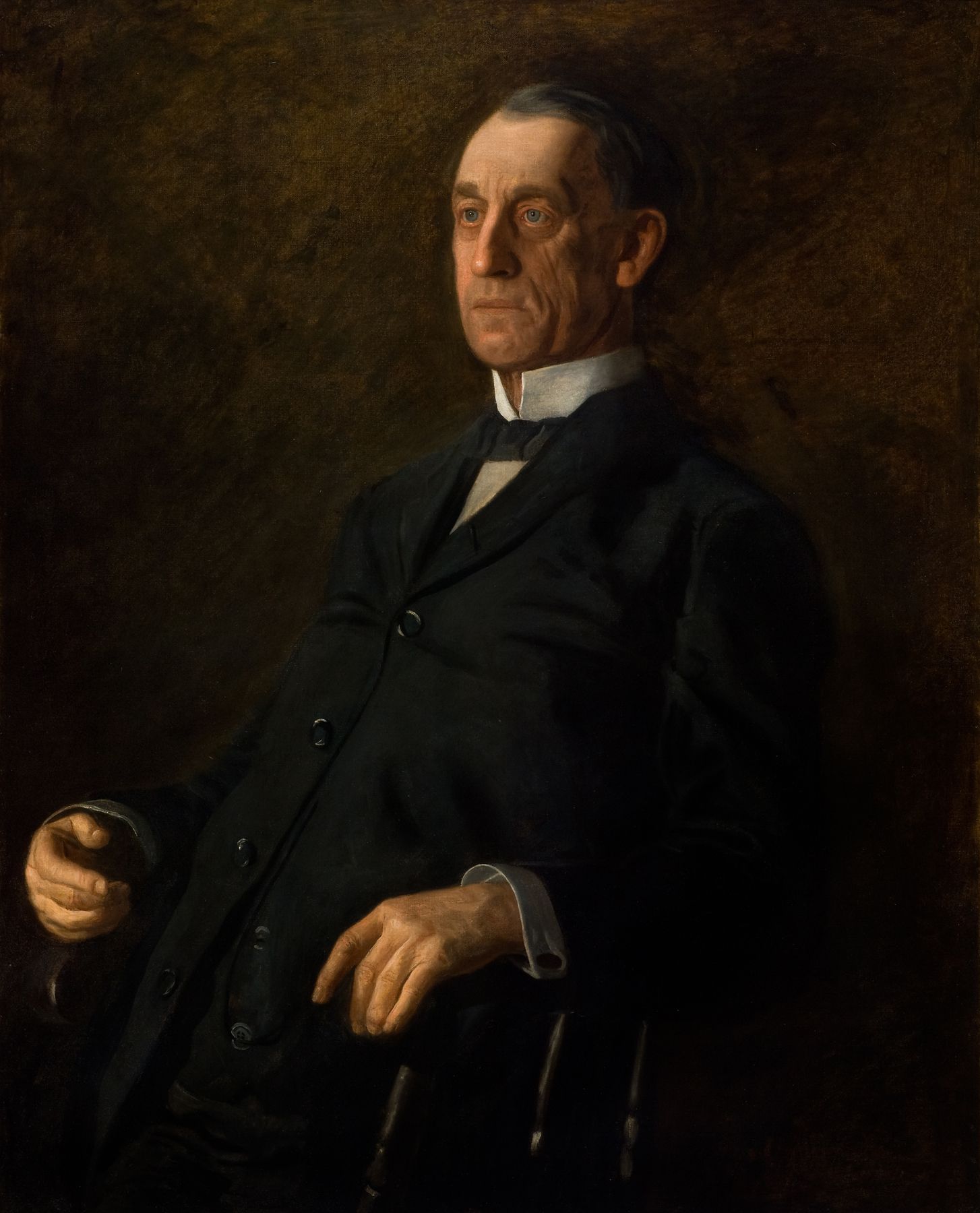
A.W. Lee
Article Published by: reynoldahouse.org
“In his late portraits, especially, Eakins sought the underlying structure and substance of the head and body and pulled no punches when it came to telling the truth about the individual who posed before him.” [1] Thomas Eakins claimed his right as an artist to read and represent the truth of what he saw before him, or what he believed the truth to be, even when it was at odds with another’s concept of the subject.
Asbury Wright Lee (1841-1927) of Clearfield, Pennsylvania, was described in his obituary notice in the Clearfield Progress as “one of the best known men in Central Pennsylvania”, and one who “sponsored and gave largely of his time, energy and money to every movement looking toward the advancement of our town, its institutions and its people.” [2] As a member of the Arts Club of Philadelphia, Lee would have been familiar with Eakins’s work.
In a typewritten letter from Clearfield dated January 29, 1905, A. W. Lee wrote to Eakins: “My dear Sir: I am sorry that I have been unable to give you a sitting. Am now going South and will return by your City in March, when I hope to be able to give you some time. Very sincerely yours, A. W. Lee” Apparently Lee was able to pose for Eakins but the end result would not satisfy the sitter. In a handwritten letter dated September 19, 1905 sent from Tyrone, Pennsylvania, Lee again wrote Eakins: “Dear Sir: You will receive the Painting back from Washington addressed Mary E. Lee, 1729 Mt. V. I may make a suggestion when I am down soon. While not accepted by me I send you a cheque for $200 anyway. In a general way my daughter liked it. Very truly yours, A. W. Lee” [3]
Was Lee correct in his assessment of the painting, or was his daughter? Eakins’s historians frequently cite this particular portrait as an instance of a sitter rejecting and returning their portrait to Eakins. Paradoxically, several art historians have in effect agreed with Lee in assessing this as an unsuccessful portrait even while they excuse Eakins and implicitly blame Lee (and other sitters) for not appreciating Eakins’s genius. William Innes Homer has written, “And the Gest and Lee portraits are among his least successful works, especially the latter. Both are wooden in their poses, and their faces have that detached, abstracted look that mars more than a few of Eakins’s later portraits. Eakins was much more comfortable painting people he knew.” [4] For art historian Darrel Sewell, it was that Lee, or any other unhappy sitter, was missing the point. “. . . Eakins’s objective observation was of the person without the intervention of their conception of their own personality. When all of these devices were applied to a sitter whom Eakins apparently found unsympathetic, the result could become devastating. A. W. Lee commissioned and paid for his portrait, but refused to accept it.” [5]
For some, the residual power of Lee’s portrait as a psychological study has made the work’s failure as an accurate likeness of the sitter increasingly irrelevant. “A more immediately impressive work is the portrait of A. W. Lee (1905), a civilized barbarian who refused to accept his portrait, but paid Eakins for it and returned it to him. Eakins’s view of him contains that kind of response. His portrait may appear one of Eakins’s harshest revelations of character, omitting nothing in its delineation of the stiff and the inhuman, from the rigidity of the man’s pose to the marmoreal quality of his long face with its hard gray-blue eyes. Yet inhumanity is not all one discovers in the man, for what had frozen in him, after all, was a superior energy. If he could not like what Eakins found in him others may be struck by the sheer power of vision in this intense work, and by something that competes with that stiff probity, that angry response to life. Lee’s eyes are not simply hard; they hint at the beginnings of self-recognition, the discovery that life had been lost in the pursuit of something else. This work belongs to moral vision, but it communicates its impression with a richness that has its sources in the response to an era and in the ability to probe the psychology of a most unlikely subject.” [6]
According to art historian Darrel Sewell, Eakins learned his technique from a brief study with the French portraitist Léon Bonnat near the end of his studies in Paris. These practices included placing sitters in surroundings appropriate to their professions and/or accomplishments, intense lighting of the subject against a dark, indeterminate background, and being realistic in the depiction of clothing worn, to depict wrinkles and folds suggestive of wear. [7] Unlike Bonnat, Eakins tended to place his sitter back from the picture plane, gazing outwardly past and not at all engaged with the viewer. Several of these techniques are employed by Eakins in A. W. Lee’s portrait. In this half-length portrait, Mr. Lee is seated in a wooden chair, of which only a few spindles and the armrests are visible. A strong light source from the left of the composition catches the edge of his high collar in a flashing gleam of white. In this nearly monochromatic painting, the effect of Lee’s pale bright blue eyes, encircled in reddish tones, is startling. In a contemporary black-and-white studio photograph by Bachrach [8], Lee is shown in a seated pose and dress nearly identical to this painting, yet the overall impression upon the viewer is vastly different. Instead of a loosely clenched right and open left hand resting on the chair arms, in the photograph, Lee’s firm fists suggest authority. In the painting, Lee’s overcoat is buttoned up and strained over his belly, whereas in the studio photograph his coat is left unbuttoned, revealing a buttoned vest and hint of a watch fob, imparting a much more relaxed and confident demeanor. Whereas, in the photograph, Lee’s coiffure appears as distinguished silver gray, in the painting his locks are limp, dark and graying. In the photograph, Lee directly regards the viewer but, in Eakins’s image, his gaze looks past us and to an indeterminate distance. The Bachrach photograph seems an appropriate illustration of Lee’s character as suggested by his obituary, while Eakins’s portrait of him seems completely dismissive of any such goal. The greatest attention is placed on the musculature of the face and the hands that could belong to any older man. By subverting the functionality of his portraiture in favor of his own aesthetic vision, influenced by life experience but subjectively presented, the claim for Eakins as the precursor to American Modernism in the twentieth century seems justified. “The singers, musicians, educators, lawyers, and churchmen in Eakins’s portraits are scarred, introspective individuals, precarious survivors of an arduous age, people stripped of innocence. Their life-battered faces, lined with anxiety and frozen in thought, expressed both Eakins’s own brooding introspection and sense of estrangement as well as the ravaging impact of time and stress upon sensitive minds. The thought-burdened intensity evident in his diverse portrait gallery encourages viewers to identify with the sitters’ emotional states, to share their existential predicament and fragility.” [9]
It is not clear whether Eakins did any preparatory work for this portrait, although there is every reason to think he did. It is also not known how many sittings Lee might have been able to give Eakins, although the dates of his letters to Eakins suggest a period of no more than six months at the most to complete the work. Recent scholarship has revealed how much Eakins used photography, as well as extensive drawing and perspective studies, in preparing for his paintings. His use of photography did not save him time but did help him impart a seeming authenticity and detachment to his compositions. He would directly project his photographs on his canvas, or he would use the traditional method of drawing a grid on a photograph for the purpose of scaling up the image to a canvas. [10] The Bachrach photograph was given to Reynolda House Museum of American Art by a descendant of the sitter and is undated, so it is not clear if Eakins ever saw it, let alone used it or another photograph for reference.
The painting, once returned, remained in Eakins’s home and as part of the estate was handled by Babcock Galleries. It was purchased by Mr. and Mrs. Lawrence Fleishman in 1953 and later acquired by Kennedy Galleries in 1966. The painting was given by Nancy Susan Reynolds and Barbara B. Millhouse to Reynolda House Museum of American Art in early 1969, in advance of the revival of interest by critics and collectors of art by Thomas Eakins in the 1970s.
About Scott Livengood
Scott Livengood is the owner and CEO of Dewey’s Bakery, Inc., a commercial wholesale bakery with a respected national brand of ultra premium cookies and crackers.
Previously, Scott worked at Krispy Kreme Doughnuts for 27 years, starting as a trainee in 1977. He was appointed President of the company in 1992, then CEO and Chairman of the Board.
Scott has served on numerous boards including the Carter Center, the Calloway School of Business and the Babcock School of Management, Habitat for Humanity of Forsyth County, and the Winston-Salem Chamber of Commerce.
He started a new business, StoryWork International, in 2016 with Richard Stone. The signature achievement to date is LivingStories, a story-based program for improved patient experiences and outcomes in partnership with Novant Health.




